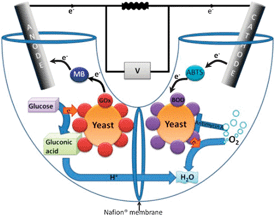Scientists from Israel have designed a biofuel cell that combines the advantages of both enzymatic and microbial fuel cells.
Biofuel cells use redox enzymes to convert chemical energy into electricity. These cells can be divided into two categories: enzymatic fuel cells which require the enzymes to be purified and microbial fuel cells which make use of an entire microorganism. There are pros and cons to both strategies – enzymatic fuel cells tend to have increased power output whilst microbial fuel cells enable full oxidation of a wider range of fuels.
Yet now, Lital Alfonta and co-workers demonstrate that by designing a hybrid cell, one can have the best of both worlds. The team have modified yeast to display redox enzymes on their surface and then introduced this into both the anode and cathode compartments. This approach removes the need to purify the enzymes and enables regeneration of both fuel compartments.
To find out more about Alfonta’s biofuel cell device, read the ChemComm article today.











